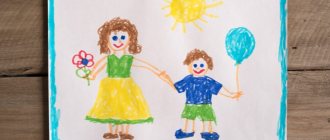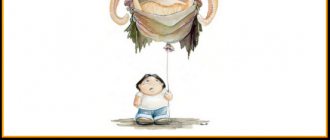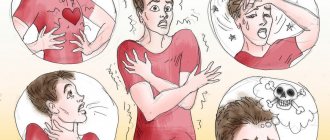The problem of children's fears is familiar to many parents. Small children are afraid of Baba Yaga, schoolchildren are afraid of answering at the blackboard, teenagers are afraid of being unattractive to the opposite sex.
Most fears are related to the child’s age and pass over time. However, if fear persists for a long time and brings anxiety not only to the child, but also to the parents, this is a reason to seriously think about it.
In this article, you will learn what kind of daytime and nighttime fears children have, what they are associated with, and how to help your child win the fight against his own fear.
Find out what your child is afraid of at school, whether everything is okay in class or in relationships with peers. To do this, use the application for caring parents “Where are my children”.
Content:
- Types of fears Daytime fears
- Night terrors
- During mother's pregnancy
- Psychotherapeutic techniques
General status information
Fear is a natural human instinct that arises as a response to a threat, a possible danger. In childhood, due to developed imagination and emotional instability, such fears in most cases are far-fetched and have no basis in reality. However, this condition is very common, is a threat to the child’s psyche and requires mandatory intervention from specialists. Childhood fear left to chance can subsequently become the cause of a real phobia, which will persist throughout the rest of life.
Types of fears
The variety of fears in children can be divided into two groups: daytime and nighttime.
Daytime Fears
Children have daytime fears:
- Natural (based on the instinct of self-preservation): fear of death, darkness, heights, animals, elements, loud sounds, confined spaces, pain.
- Social: fear of loneliness, people, punishment, being late, condemnation.
- Situational: fear as a consequence of a traumatic situation (a child who almost drowned in a lake is now afraid to swim even in the pool).
- Personal: fears are associated with the individual characteristics of the child (shyness, isolation, anxiety).
- Imaginary: fear of monsters, Green Hand, Black Mask, etc.
- Obsessive fears or phobias: strong and overwhelming fear associated with some event or phenomenon in a person’s life.
Night terrors
Night terrors in children can manifest themselves in the form of nightmares, sleepwalking and sleep talking. Scary dreams can recur and haunt a child almost every night. The process of the appearance of such dreams is associated with the work of the brain, which continues to work at night and processes information received during the day.
Research has shown that approximately 3% of all children on the planet under 14 years of age suffer from night terrors.
Causes of night terrors in children:
- sensitivity, anxiety and suspiciousness of children, as well as their parents;
- suffered stress;
- change of usual environment;
- painful condition, fever;
- accidents, fear;
- unfavorable family situations (quarrels between father and mother, divorce);
- emotional alienation of parents;
- increased demands on the child, frequent physical punishment.
Most often, nightmares haunt children from 5 to 12 years old.
The child begins to be afraid to fall asleep alone and asks to leave the light on or lie down with one of the parents. He sleeps restlessly, tosses and turns, and sometimes even screams. In the morning he feels lethargic, overwhelmed, depressed, and begins to be capricious. Parents also begin to get nervous, irritated, and take it out on the child. In the evening, everything repeats all over again - restlessness, growing anxiety, the child’s reluctance to go to sleep.
To prevent the situation from becoming critical and the child’s night fears from developing into pathology, the help of a neurologist or psychotherapist is needed. Parents should follow the recommendations that will be discussed later.
Classification
By type, children's fears are classified in a variety of areas, ranging from the causes of their occurrence to the severity of symptoms. In general, all conditions are divided into three groups:
- obsessive fears that are caused by actually experienced life situations (fear of animals, heights, confined spaces, water);
- delusional fears, when the logical relationship between the object of fear and the cause of fear is illogical, even absurd;
- overvalued fears, when the starting point is any event that activates the child’s fantasy; this condition does not go away, the fear gradually grows, covering all the thoughts and feelings of the baby.
In children, the most common are supervaluable types of fear, which the child cultivates in himself, inventing new details, endowing the object of fear with amazing abilities and qualities.
What are children afraid of at different ages?
During mother's pregnancy
Yes, yes, the child becomes familiar with the feeling of fear during intrauterine development, when the mother experiences severe anxiety. The released portion of hormones passes through the placenta from mother to child, and in response to this, the baby may exhibit severe motor restlessness - pushing, kicking. This is how he reacts to fear.
In the first months of life
Anxiety in infants is often associated with unmet physiological needs. Later, the need for emotional contact with mom appears. If the mother is strict, unkind, rarely approaches and smiles at the child, he becomes capricious and restless. Babies are also afraid of separation from their mother, strangers and loud noises.
From 1 year to 3 years
The child grows, and with him his motor activity and desire to understand the world grow. And suddenly an affectionate and kind mother begins to forbid him something, limit his freedom, and raise her voice. Naturally, the child in this situation begins to experience anxiety and restlessness.
If adults maintain a balance between what is possible and what is not, the child grows up calm and self-confident. He gets his first experience of the dangers of the world around him (fire burns, ice is cold, if you pinch your finger in a door it will hurt) and learns to avoid them.
If in a child’s life there are only restrictions and prohibitions, overprotection reigns in the family, then the child grows up anxious and dependent, afraid of his own shadow.
Babies also have a strong fear of pain. Hence the whims and hysterics before going to the doctor, the fear of injections and other surgical interventions.
From 4 to 5 years
By the age of 4, children develop fears of fairy-tale characters (Baba Yaga, Koschey the Immortal, the Wolf and others). The fear of these creatures is associated with disturbing relationships between the child and adults, primarily in the family. Baba Yaga is the image of an evil, cruel, uncompromising woman. Koschey the Immortal is rude, stingy, heartless. The wolf is aggressive and dangerous.
Children are also afraid of the dark, afraid to fall asleep and be left alone at home. This is due to the fact that a child, left without parents, feels that he cannot independently protect himself from the dangers surrounding him.
From 6 to 7 years
At older preschool age, children begin to fear death. Both your own and the death of your parents.
Fears of darkness and loneliness also remain strong. The fear of fairy-tale characters is replaced by the fear of ghosts, monsters, aggressive cartoon characters and computer games.
From 8 to 11 years
By the time a child goes to school, the number of his fears decreases.
But so-called “school” fears appear: being late for school, answering incorrectly at the blackboard, fear of a strict teacher and classmates.
There is even the term “school phobia” - an obsessive fear of going to school. Often this fear is due to the fact that the overprotected child experiences separation from his parents while at school and doubts his ability to cope with all school tasks.
Parents can also unknowingly contribute to the development of “school phobia” by constantly monitoring the child’s homework and scolding him for poor grades.
Also, younger schoolchildren are afraid of not meeting social requirements: being a bad student, an unreliable friend, an unloved son or daughter.
In addition to “school” fears, children at this age are afraid of natural disasters: hurricanes, tornadoes, earthquakes, as well as the dead and ghosts.
Find out what your child is afraid of at school, whether everything is okay in class or in relationships with peers. To do this, use the application for caring parents “Where are my children”.
From 11 to 16 years old
During adolescence, children undergo active puberty, their figure and voice change, and their body weight increases or decreases. Therefore, many begin to experience the fear of change, the fear of being ugly, ugly, unattractive to the opposite sex.
The fear of death reaches its peak at this age. Children are afraid of war, serious illness, or a terrorist attack.
“Social” fears also reach their peak: fear of ridicule, condemnation, rejection by peers, and even bullying.
Girls are more susceptible to fear than boys due to their impressionability and emotional vulnerability.
In adolescence, as in preschool: the stricter and more intolerant parents are towards their child, the more fears he has.
Fears contribute to the appearance of self-doubt, isolation, increased anxiety and depressive thoughts in a teenager.
From 1 year to 3–4 years
After a year, the child begins to walk, gains freedom of action and actively explores the world. It is important that parents find a balance between encouraging independence and healthy parenting. Excessive prohibitions can develop timidity, apathy, or, on the contrary, give rise to a tendency to circumvent restrictions and take risks.
Also at this age, fear of pain appears - children usually associate it with going to the doctor. It is important to explain to the child the essence of medical procedures in understandable language, to avoid harsh pressure, and, if possible, to be nearby during the procedures.
Causes of fears in a child
1. Overprotection combined with increased anxiety of parents.
Worried parents, worried about any reason, unconsciously give the child the message: “This world is full of dangers. You can't handle them on your own. Always be with us, and we will protect you."
Only children in the family suffer especially in this regard.
The age of the parents also plays an important role. The older the parents, the more concerned they are about the life and health of the child.
2. Conflicts between parents, frequent physical punishment, especially from the father.
A child in such an atmosphere grows up fearful and unsure of himself.
3. Emotional “coldness” of parents.
The child does not develop basic trust in the world, a sense of security and safety.
4. Psychotraumatic situation in the past, fear.
Any negative experience experienced can take hold and cause feelings of fear in the future. For example, if a child was bitten by a dog as a child, as an adult he will avoid and be afraid of even small dogs.
5. Films, videos, computer games with scary characters.
A child’s thinking is not yet critical, and many begin to fear monsters from films in the real world.
6. Mental disorders.
Children with mental disorders are also characterized by numerous fears. This especially affects children with autism spectrum disorder.
Harlow's experiment proved that children need parental warmth to be healthy.
In the 1950s, American psychologist Harry Harlow conducted a series of experiments that may have been cruel, but radically changed ideas about child care. Harlow formed a group of baby monkeys who were separated from their mothers and placed in a cage with two "mom surrogates" - a wire figure with a bottle of milk and a soft figure covered with cloth. Here's what we found out.
Without a good mother it’s bad. It quickly became clear that the monkeys prefer to spend time hanging on a soft figure, although she does not have milk, and they only approach the wire “mother” to eat. When only she was left, the monkeys began to behave like autistic children - huddled on the floor, avoided contact, rocked back and forth.
An evil mother is still a mother. At the last stage of the experiment, Harlow created a model of the “evil mother” - he placed a soft figure in a cage, which was equipped with a device that suddenly repels the monkeys or releases thorns. But even after suffering from such treatment, the animals returned to the “evil mother” and remained attached to her.
After the end of the experiment, the monkeys never recovered. As adults, they remained more timid and nervous compared to monkeys who grew up under normal conditions.
As a result, the scientist concluded that nutrition and good care alone are not enough for a child - without tactile contact (touching, hugs, affectionate treatment) he will not be able to maintain mental health.
How to recognize childhood fear?
In babies, fear is expressed in freezing or, conversely, in increased motor restlessness; they cry, hide behind their mother, or run away. The source of fear in this case is not difficult to identify.
Preschoolers and schoolchildren cannot always talk about what scares them. Parents should be wary of the child's constant tension, motor agitation, increased fatigue, restless sleep, frequent headaches, moodiness and tearfulness. All this suggests that the child is in a state of chronic restlessness and anxiety, and he will need the help of a psychologist.
The main methods for diagnosing fears in children over 3 years of age are based on drawings (“Drawing of a family”, “Draw what you are afraid of”). Methods such as “Fears in the Houses” and “Finish the Fairy Tale” are also used. With their help, you can find out what worries and worries the child, what fears predominate in him.
In high school and adolescence, psychologists use questionnaires that allow them to assess the degree of psycho-emotional stress of the child, the level of anxiety and predisposition to neurosis.
Carefully find out what is really going on with your child and help him cope with his fears. Install the “Where are my kids” parental control app to know where he is, what he is doing and who he is spending time with.
Diagnostics
The main way to determine the presence, cause and level of fear is a conversation between the child and a specialist. Using psychotherapeutic techniques and questionnaires, the doctor can identify the original source of the experience and assess the child’s current emotional state. The so-called projective techniques, when a psychologist asks children to draw or express their fear in other creative ways, have considerable diagnostic value in this regard.
In the case of real mental disorders, a standard set of examinations is carried out, including laboratory tests, EEG, MRI of the brain, consultations with a neurologist, pediatrician and other specialized specialists.
How to help your child cope with his fears?
Psychotherapeutic techniques
In the fight against children's fears, the most effective psychotherapeutic techniques, which, with certain preparation, can be used by parents:
Drawing
By drawing, a child gives vent to his feelings and experiences, desires and dreams, models reality, and painlessly comes into contact with frightening, unpleasant and traumatic images.
Try inviting your child to draw what he is most afraid of. After this, you can tear up the drawing, burn it, throw it out the window with the words “Here we have conquered your fear. How brave and courageous you are!”
A game
In role-playing games, children acquire certain skills, learn social forms of behavior, and take on different roles.
A child, joining the game, crosses the threshold of shyness and fear, wins victories and suffers defeats, and gains self-confidence.
The game “I’m not afraid of horror stories, I’ll turn into whoever you want” is popular in children’s institutions. The children “turn” into a scary character (Koshey the Immortal, dragon, etc.), whom the driver names, and freeze. The driver chooses the child who turned out this character best, and he becomes the driver.
Fairy tale therapy
This method is used in the correction of fears and anxiety in children starting from the age of five. A special fairy tale is selected or an original one is composed that reflects the child’s specific fear. As the story progresses, the characters defeat him.
Using the example of fairy-tale heroes, a child learns to look his fears in the face and not be afraid to fight them.
How to overcome night terrors?
For a child to sleep peacefully at night without nightmares, he must feel safe and know that he is not in danger.
- Under no circumstances should you scold or shame your child for being capricious and not wanting to sleep alone. Sit next to him, calm him down, stroke his head, wait until he falls asleep.
- During the day, the child needs physical activity in the fresh air and outdoor games.
- 2-3 hours before bedtime, the child should not have:
- computer games;
- cartoons and fairy tales with scary characters;
- quarrels and clarification of relationships in the family;
- heavy food;
- stuffiness in the room;
- tight, uncomfortable sleepwear.
- The time to fall asleep should be the same, regardless of whether it is a weekday or a weekend.
- Waking up a child should not be abrupt. It is better to use not an alarm clock, but mother’s touches and strokes.
- Strengthen your child's body. Exercising and a healthy lifestyle will be the best prevention of night terrors.
From 7 to 12 years
The beginning of school life is the equator beyond which natural and “fantasy” fears increasingly give way to social ones. Children who grew up in overprotective conditions may have a hard time being separated from their parents and having to cope with school assignments on their own.
Parents often aggravate the situation by attaching excessive importance to grades, forcing them to rewrite homework multiple times, etc.
How to overcome children's fears associated with school and help a child not be afraid of this new stage of life? In the first grades, you should focus not so much on grades, but on whether the child understands the program as a whole, what blind spots he has.
If there is understanding, the marks will improve on their own. And do not forget that school is only a part of life; in addition to lessons, children should have interests and hobbies.
Recommendations for parents
Helping a child cope with his fears means understanding his feelings, hearing his own “I” and strengthening self-confidence.
- Joint activities of the child with adults and peers help to cope with children's fears: walks, games, visiting a puppet theater, circus, sporting events. The more interests children have and the more varied their lives, the less they will be fixated on their fears, concerns and anxieties.
- Take an active part in your child's life, but don't try to control everything. The child must trust you and share his secrets with you.
- Create a comfortable, calm atmosphere at home in which the child feels loved and protected.
- In no case should you frighten your child with fairy-tale characters for the purpose of discipline (“If you behave badly, Baba Yaga will take you away, the dragon will drag you away”, etc.).
- Do not discuss disasters, accidents, stories about ghosts and the other world in front of your child. Children are impressionable, and such conversations remain in the memory for a long time. Many, even when they become adults, still remember what scared them in childhood and what scary stories adults told.
- Teach your child to a clear daily routine and follow it even on weekends and holidays.
- Reduce the amount of time your child spends on gadgets.
- Do not make fun of the child’s fear, do not try to explain to him that there is nothing to be afraid of. It’s better to say, “I’m with you, I understand that you’re scared.”
- Be patient. Most fears go away on their own with age. The main thing is to prevent them from poisoning the child’s life and developing into pathology.
- The psychology of children's fears is such that most of them are born in the family. Pay attention to your own psychological well-being. If you yourself are naturally anxious and restless, try not to pass these feelings on to your child.
- Don't ignore your child's fears. If you don’t know what to do or how to help your child, seek advice from a psychologist.
Treat children's fears as an inevitable phenomenon of a child's growing up, without unnecessary worry, condemnation, and even more so, ridicule. If a child feels the love and care of adults, and is sure that he will be supported and protected in any situation, then he will be able to independently win the fight against his fears.
5
From 12 to 16 years old
Adolescence is a time of social fears that crowd out all others. The child is going through puberty, his appearance is rapidly changing, and hormonal changes are underway.
This is how the fear of becoming ugly and becoming an object of ridicule arises. To reduce such fears to a minimum, it is important to instill in a teenager self-care skills, the habit of regularly exercising, and monitoring nutrition.
It is also important that the teenager has hobbies, his own company of like-minded people and friends. Sports or creative classes, hobbies help to avoid depressive thoughts and make it easier to overcome an identity crisis.
Drawing psychotechnics
Ask your child to draw a family and analyze where he places himself and his loved ones. Children who picture themselves apart from their families experience loneliness and a feeling of abandonment.
Pay attention to whom the child’s figure is closest to - this is the most significant adult for him, from whom support is expected. See whose figure is shaded the most. Strong pressure is a sign of emotional tension associated with a given person.
You can also ask the child to draw his fear and ask where he lives, what he likes and what he doesn’t like, what he is afraid of. The result is a tale of fear - come up with a good ending.
Fairy tale therapy
The essence of the method is to use fairy-tale characters to give the child an example of how to deal with fears and win. To do this, you can take ready-made psychotherapeutic fairy tales or compose your own.
Choose characters, label them with dolls or animals, and then come up with a plot together with your child. Ready-made fairy tales can be read to children from 3 years old, but you can only come up with your own with an older child.
Children's fears are an integral part of growing up, and if they do not turn into phobias, they should be perceived as normal. A child will easily overcome these emotions if he grows up in an atmosphere of care and understanding.
Remember that a psychologist’s advice only provides a tool for combating fears, but only parents can create a suitable environment for this.









